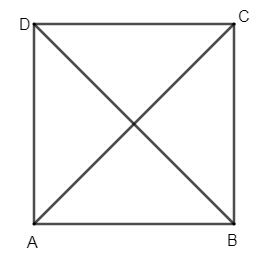
The diagonals of a rectangle are perpendicular to each other.
(a). True
(b). False
(c). Only when the rectangle is also a rhombus.
(d). None of these.
Answer
597.9k+ views
- Hint: Draw a rectangle, with diagonals. From the figure, find out if the diagonals are perpendicular to each other or not, if they are then the statement is true or else the statement is false.
Complete step-by-step answer: -
Consider the rectangle ABCD drawn below.

We know that a rectangle has 2 diagonals. From the figure we can see that AC and BD are the diagonals of the rectangle ABCD. From the figure we can understand that each one is a line segment drawn between the opposite corners of the rectangle. The diagonals of the rectangle are equal i.e. AC = BD and they bisect each other. But the diagonals are not perpendicular to each other. We know that if diagonals are perpendicular then they cut at \[{{90}^{\circ }}\]. But in the rectangle the diagonals don’t cut at \[{{90}^{\circ }}\]. Thus the statement given is false.
If in case of square and rhombus, the diagonals are perpendicular to each other. But for rectangles, parallelograms, trapeziums the diagonals are not perpendicular.
\[\therefore \] The diagonals of a rectangle are not perpendicular to each other. The given statement is false.
\[\therefore \] Option (b) is the correct answer.
Note: If you are having doubt about the diagonals if they are perpendicular or not always draw a figure and confirm it. If we draw a rectangle with diagonals, we can see that they are not perpendicular. If we draw a square, their diagonals are always perpendicular.
Complete step-by-step answer: -
Consider the rectangle ABCD drawn below.

We know that a rectangle has 2 diagonals. From the figure we can see that AC and BD are the diagonals of the rectangle ABCD. From the figure we can understand that each one is a line segment drawn between the opposite corners of the rectangle. The diagonals of the rectangle are equal i.e. AC = BD and they bisect each other. But the diagonals are not perpendicular to each other. We know that if diagonals are perpendicular then they cut at \[{{90}^{\circ }}\]. But in the rectangle the diagonals don’t cut at \[{{90}^{\circ }}\]. Thus the statement given is false.
If in case of square and rhombus, the diagonals are perpendicular to each other. But for rectangles, parallelograms, trapeziums the diagonals are not perpendicular.
\[\therefore \] The diagonals of a rectangle are not perpendicular to each other. The given statement is false.
\[\therefore \] Option (b) is the correct answer.
Note: If you are having doubt about the diagonals if they are perpendicular or not always draw a figure and confirm it. If we draw a rectangle with diagonals, we can see that they are not perpendicular. If we draw a square, their diagonals are always perpendicular.
Recently Updated Pages
Master Class 12 Business Studies: Engaging Questions & Answers for Success

Master Class 12 Economics: Engaging Questions & Answers for Success

Master Class 12 English: Engaging Questions & Answers for Success

Master Class 12 Maths: Engaging Questions & Answers for Success

Master Class 12 Social Science: Engaging Questions & Answers for Success

Master Class 12 Chemistry: Engaging Questions & Answers for Success

Trending doubts
Who was the first woman to receive Bharat Ratna?

Write a letter to the principal requesting him to grant class 10 english CBSE

Why is there a time difference of about 5 hours between class 10 social science CBSE

What is the median of the first 10 natural numbers class 10 maths CBSE

The Equation xxx + 2 is Satisfied when x is Equal to Class 10 Maths

Discuss the main reasons for poverty in India




